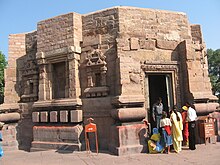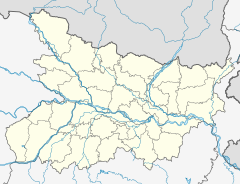Mundeshwari Temple
| Mundeshwari Temple | |
|---|---|
 Nagara style architecture of the temple. | |
| Religion | |
| Affiliation | Hinduism |
| District | Kaimur district |
| Deity | Shiva and Shakthi |
| Festivals | Ramnavami, Shivratri, Navaratra |
| Location | |
| Location | Paunra Pahad, Ramgarh village |
| State | Bihar |
| Country | India |
| Geographic coordinates | 24°59′00″N 83°33′53″E / 24.9833958°N 83.5646939°E |
| Architecture | |
| Completed | 108 CE[1] Hindu inscriptions dated 4th century CE were found in the temple.[citation needed] |
| Specifications | |
| Temple(s) | One |
| Elevation | 608 m (1,995 ft) |
The Mundeshwari Devi Temple (also spelled Mundesvari) is a Hindu temple, located at Ramgarh Village, 608 feet (185 m)[2] on the Mundeshwari Hills of Kaimur plateau near Son River, in the Bhojpuri region of Indian state of Bihar. It is an Archaeological Survey of India (ASI) protected monument since 1915.[3] The ASI has dated the structure to 108 CE making it the oldest Hindu temple in the world.[4][5][6][7]
It is an ancient temple which is believed to be dedicated to the worship of the goddess Durga and god Shiva is considered as the oldest functional Hindu temple of the World.[8][9][10] The findings also established that here was a religious and educational center spread over the hillock and Mandaleshwar (Shiva) temple was the main shrine. The Mandaleshwari (Durga) was on the southern side. The temple was damaged and the idol of Mandaleshwari (degenerated Mundeshwari and later connected with the mythical demon Mund) was kept in the eastern chamber of the main temple.[11]
History
[edit]

Timelines
[edit]- 636 - 38 - Chinese visitor Huen Tsang writes about a shrine on a hill top flashing light, at about a distance of 200 lee south west to Patna-The location is only of Mundeshwari.
- 1790 - Daniel brothers, Thomas and William visited Mundeshwari temple and provided its first portrait.
- 1888 – Buchanan visited the region in 1813.
- 1891-92 – First part of the broken Mundeshwari Inscription was discovered by Bloch during a survey by East India Company.
- 1903 – Second part of the temple was discovered while clearing the debris around the temple.
- 2003 – Brahmi script royal seal of Sri Lankan king Dutthagamani (101-77 BCE) was discovered by Varanasi-based historian Jahnawi Shakhar Roy which changed the earlier findings about history of the place.
- 2008 - The date of the inscription was established 30th year of Saka era (108 CE) by the scholars in a national seminar organized for the purpose by Bihar State Religious Trust Board at Patna.[4][5][6]
Deity
[edit]The worship of Devi Durga in the form of Devi Mundeshwari in the temple is also indicative of tantric cult of worship, which is practiced in Eastern India.[8]
Religious significance
[edit]Rituals and worship have been performed here without a break, hence Mundeshwari is considered one of the most ancient Hindu temples in India. The temple is visited by a large number of pilgrims each year, particularly during the Ramnavami, Shivratri festivals.[8] A big annual fair (mela) is held nearby during the Navaratra visited by thousands.[12]
Architecture
[edit]The temple, built of stone, is on an octagonal plan, which is rare. It is the earliest specimen of the Nagara style of temple architecture in Bihar. There are doors or windows on four sides and small niches for the reception of statues in the remaining four walls.[13] The temple shikhara or tower has been destroyed. However, a roof has been built, as part of renovation work. The interior walls have niches and bold mouldings which are carved with vase and foliage designs. At the entrance to the temple, the door jambs are seen with carved images of Dvarapalas, Ganga, Yamuna and many other murtis. The main deities in the sanctum sanctorum of the temple are of the Devi Mundeshwari and Chaturmukh (four-faced) Shiva linga. There are also two stone vessels of unusual design.[14] Even though the Shiva linga is installed in the centre of the sanctum, the main presiding deity is Devi Mundeshwari deified inside a niche, which is seen with ten hands holding symbols riding a buffalo, attributed to Mahishasuramardini.[15] The temple also has murtis of other popular gods such as Ganesha, Surya and Vishnu. A substantial part of this stone structure has been damaged, and many stone fragments are seen strewn around the temple. However, under the jurisdiction of ASI, it has been the subject of archaeological study for quite some time.[3][8][16][17]
Renovation and restoration
[edit]The Archaeological Survey of India has restored the temple under instruction from the Union Ministry of Culture. Restorative works included the removal of soot from the temple interior via a chemical treatment, repair of damage to religious murti (idol) and cataloging and documentation of scattered fragments for later reuse. Other works included installation of solar powered lighting, displays for antiquities and provision of public amenities. The Government of Bihar has allocated Rs 2 crore to improve access to the temple.[18][17]
How to reach
[edit]It can be reached by road via Patna, Gaya, or Varanasi. The nearest railway station is at Mohania - Bhabua Road railway station from where the temple is 22 km by road.[16] Lal Bahadur Shastri International Airport, Varanasi is the nearest airport, located at a distance of 102 km from the Temple. Indian carriers including Air India, Spicejet, and international carriers like Air India, Thai Airways International, Korean Air and Naaz Airlines operate from here. Daily flights to Delhi, Mumbai and Kolkata are available from here.
See also
[edit]- Murugan Temple, Saluvankuppam
- Chandika Sthan
- Mangala Devi Kannagi Temple
- Maa Jaleshwari Temple
- Ajgaibinath Temple
References
[edit]- ^ The information plaque erected by the Archaeological Survey of India (ASI) at the site indicates the dating of the temple to 635 CE but the Bihar State Religious Trust Board fixed its date in 108 CE.

- ^ "Alphabetical List of Monuments – Bihar". Serial number 62. Archaeological Survey of India. Archived from the original on 2011-11-03. Retrieved 2011-06-03.
- ^ a b "BSBRT to renovate Mundeshwari temple". The Times of India. 1 January 2011. Archived from the original on 14 June 2012. Retrieved 2 June 2011.
- ^ a b "Mundeshwari Temple: Department of Tourism, Bihar Government". Archived from the original on 2021-09-18. Retrieved 2021-09-18.
- ^ a b "Bihar: India's 'oldest serving deity' invoked for quake protection". Hindustan Times. 2015-04-27. Retrieved 2021-09-18.
- ^ a b "Bihar govt to develop country's oldest temple". The Economic Times. Retrieved 2021-09-18.
- ^ "Mundeshwari Devi Temple: World's Oldest Functioning Hindu Temple Is In Bihar". Times Now. 2024-05-07. Retrieved 2024-11-16.
- ^ a b c d "Ma Mundeshwari Temple in Kaimur, Bihar". Hindu Temples. Archived from the original on 9 November 2018. Retrieved 2 June 2011.
- ^ "Film on 'oldest' surviving temple of Gupta Age". The Times of India. 12 June 2011. Archived from the original on 5 November 2011.
- ^ "Bihar to develop 'oldest' temple". The Times of India. 18 January 2008. Archived from the original on 13 September 2012.
- ^ Neuss, Jürgen (2003). "The Temple of Mundesvari: Reconsidering the Evidence". Berliner Indologische Studien: 531–585.
- ^ "Temples and Legends of Bihar, Mundeshwari". Hindubooks.org. p. 11. Archived from the original on 22 April 2016. Retrieved 5 June 2011.
- ^ "Mundesvari". Hindu Books.org. Archived from the original on 3 April 2012. Retrieved 5 June 2011.
- ^ "Mundeshwari temple". Plaque by Archaeological Survey of India. Archived from the original on 25 January 2013. Retrieved 2 June 2011.
- ^ "Mundesvari". Hindu Books.org. Archived from the original on 3 April 2012. Retrieved 5 June 2011.
- ^ a b "Maa Mundeshwari Mandir". Google Maps. Retrieved 4 June 2011.
- ^ a b "Facelift to the Mundeshwari temple". Hindustan Times. 3 January 2011. Archived from the original on January 25, 2013. Retrieved 5 June 2011.
- ^ "Govt to develop Ma Mundeshwari Temple". Bihar Times. 19 January 2008. Retrieved 2 June 2011.


